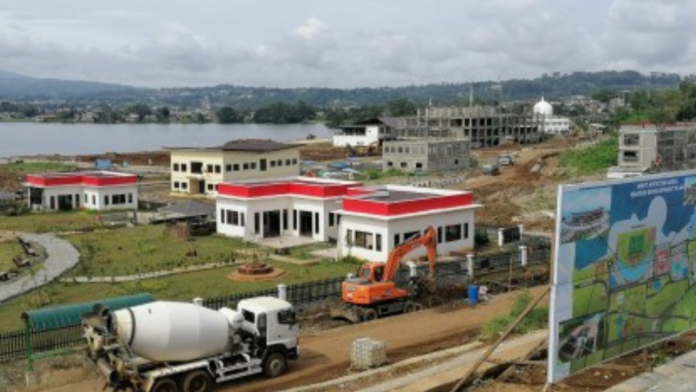MANILA – Task Force Bangon Marawi (TFBM) will see to it that at least 95 percent of Marawi City’s recovery projects from the 2017 siege will be completed by June.
TFBM chief and housing czar Secretary Eduardo del Rosario said former displaced families residing within the most affected (MAA) or the so-called “ground-zero” are now experiencing normalcy.
“I can say that 2021 has been a fruitful year for TFBM, the Marawi City local government, and especially for our Maranaw brothers and sisters who are now enjoying the initial fruits of the ongoing rehabilitation,” Del Rosario said in a statement that summed up the year just ended for the task force.
As of the first week of December 2021, the TFBM has completed about 85 percent of major rehabilitation works while the rest of the infrastructure projects are in the final stages.
“I am certain that we can finish at least 95 percent of all major infra projects by June 2022, and I can assure everyone that the few remaining projects will surely be completed because they are already funded and for implementation by the concerned agencies,” Del Rosario added.
Despite challenges such as inclement weather and the Covid-19 pandemic, TFBM projects passed construction standards and are within the timeline.
Aside from 56 implementing agencies, TFBM tapped civil society organizations (CSOs) to work as the government’s third-party monitoring group, granting them access to regular inspections of the projects.
CSOs based in Lanao del Sur have repeatedly expressed satisfaction with the rehabilitation efforts.
Key projects
Since going full blast in July 2020 when the pandemic just started, TFBM has repaired three major bridges and opened more than 20 kilometers of transcentral roads.
Also completed within the MAA were the construction of the Community Police Action Center, fire substation, maritime outpost, Barangay Rorogagus Health Station with medical supplies, central police station, and a solar power irrigation system.
Six village complexes with a health center and madrasah (school) were likewise finished while 18 more similar projects will be operational within the first quarter of 2022.
The rehabilitation of the iconic Grand Mosque ended in October, a crucial element in the social healing of residents, and was turned over to its administrators on December 2.
Also known to locals as the Islamic Center, the Grand Mosque is regarded as the biggest place of Islamic worship in the country with a floor area of 9,484 square meters and can accommodate some 20,000 worshippers.
Public facilities and infrastructure projects in the final stages of completion include four-story school buildings, Rizal Park, Traffic Command Center, the mall-like Grand Padian Market with an ice plant, Marawi Museum, School of Living Traditions, Marawi City Jail, and Marawi Command Center.
The construction of the Sarimanok Sports Stadium, Lake Lanao Promenade, and Marawi City Convention Center are likewise underway.
Slowly but surely
Del Rosario noted that more displaced families residing in the 24 most devastated barangays began the new year rebuilding or refurbishing their homes.
“We expect that by January (2022), hundreds or even a thousand can already start the construction or repair of their houses,” he said as the local government vowed to expedite the release of building permits to about 1,500 applicants residing in the MAA.
Authorities assist in addressing issues on lot ownership while the debris management and bomb excavation teams ensure the safety of residents.
The TFBM has so far allowed the return of displaced families from Sectors 1 to 3, composed of three villages inside MAA, to rebuild their homes, to be followed by those from Sectors 4 to 9.
A treatment plant will supply 5 million-liter potable water daily to residents.
Agents of progress
In October 2021, President Rodrigo Duterte personally led the commemoration of the fourth anniversary of Marawi’s liberation.
He commended the TFBM for its unwavering commitment to bring back the glory of the Islamic city.
“We mark this historic occasion by allowing the rays of hope to light up the darkness that once enveloped the city of Marawi. I congratulate and commend the Task Force Bangon Marawi, as well the local officials and other partners, for working together to rehabilitate the city,” Duterte said in his message.
The President noted that the TFBM and its partner agencies have been steadfast in rebuilding the lives of displaced families, as well as in restoring damaged properties and revitalizing disrupted socio-economic activities.
“You have stayed true to your commitment as agents of progress and catalyst for change,” President Duterte said.
Del Rosario vowed the TFBM will accomplish its mandate to rehabilitate Marawi.
“I envision the Marawi rehabilitation to be a catalyst for sustainable growth and development, a template of good governance, and lasting peace,” del Rosario said.
The TFBM was created on June 28, 2017 under Administrative Order No. 3 to ensure collaboration and convergence among national agencies and local government units and help displaced families recover. (PNA)


